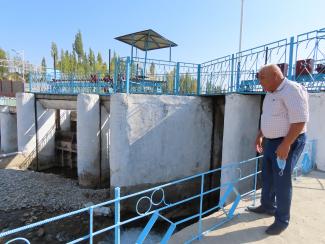Small Basin Councils: Key to Transboundary Water Cooperation in Central Asia
“Small Basin Councils are one of the most effective tools for cooperation between countries in managing and using transboundary water resources,” believes Nurmamat Khudayberdiev, who has spent more than four decades working in Uzbekistan’s water sector.
A Small Basin Council is a local governance body, made up of a wide range of stakeholders, responsible for resolving water related issues with the community. As a consultant for the USAID Smart Waters activity that ended in 2020, and Secretary of the Padshaata Small Basin Council in Uzbekistan, Nurmamat pioneered the implementation of the basin approach for local-level water resources management. This approach considers the entirety of a watershed management system rather than focusing on independent administrative sub-regions.
Nurmamat was born in the Yangikurgan district, Namangan region of Uzbekistan. Since childhood, he witnessed seasonal water supply shortages from the transboundary Padshaata River that runs through the Kyrgyz Republic and Uzbekistan. He began his professional career as a factory engineer. In 1983, he started working in the water sector and soon realized that cooperation between local water management specialists among neighboring countries is essential for the Yangikurgan district, the most water-short district in the Namangan region.
Originating in the Kyrgyz Republic, the Padshaata River is the only water source for more than 18,000 hectares of irrigated land in the Yangikurgan region. A continuous water supply depends on good relations between neighboring countries. “In the past, we faced issues of misunderstanding and sometimes the water supply was cut off by the Kyrgyz side. However, it is not the case anymore,” says Nurmamat.
The situation changed when, in 2017, USAID supported the creation of Small Basin Councils on both Uzbek and Kyrgyz sides of the Padshaata River. Nurmamat was elected the Secretary of the Padshaata Small Basin Council on the Uzbek side. He participated in numerous training and exchange visits and, in cooperation with his Kyrgyz counterparts, helped to organize the first “Padshaata River Day,” a celebration to highlight water cooperation and friendship across the river.
“The creation of Small Basin Councils enabled us to start talking to each other and solve problems in cooperation with our Kyrgyz colleagues. We now collaborate to improve the irrigation infrastructure and other issues. We have seen the effect of our Small Basin Councils many times, especially during periods of low waterflow. For example, in September-October, when irrigation on the Kyrgyz side stops, we receive water for irrigation on the Uzbek side with the help of our Kyrgyz counterparts. We have become friends,” says Nurmamat.
The communities continue to work together to address shared challenges. Although much has been accomplished, Nurmamat says there is more work to be done. He dreams of the Small Basin Councils becoming more sustainable. “I think we need to learn from each other and exchange experience with the basin councils of other countries. This will help us to make sustainable contributions to the region’s improved water resource management.”
Strengthening capacity and ensuring the sustainability of Small Basin Councils now continues under the USAID Regional Water and Vulnerable Environment activity. USAID recently completed an assessment to identify opportunities to strengthen the organizational capacity of Small Basin Councils. Nurmamat, along with 19 members of his Padshaata Small Basin Council, actively participated in the assessment.
The USAID Regional Water and Vulnerable Environment activity will soon start convening a forum of basin organizations. The forum will serve as a platform to discuss Small Basin Council experiences across the region, link larger basin councils and other water governance bodies, and promote private sector engagement.
“Small Basin Councils are the future of water management,” concludes Nurmamat. With the combined efforts of USAID, governments, other donors, the private sector, and citizens, their future is growing stronger by the day.

Региональный проект USAID по водным ресурсам и окружающей среде
